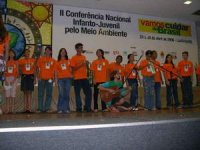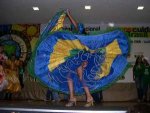

Início
Let’s Take Care of Brazil: A Unique Educational and Social Achievement
por Edith SIZOO
Temas fortes ligados:
Educação e responsabilidade .
Meio ambiente e responsabilidade .
Temas largos ligados:
Crianças .
Educação .
Environment .
Educação Ambiental .
Youth .
Second National Children’s Conference on Responsibility for the Environment
"Yound people are not so much concerned with their destiny
but rather with hope."
A Brazilian teacher
Just imagine…
Involving 12.000 schools and the communities around them, thus mobilizing within one year nearly 4 million people to reflect on fundamental questions related to the future of humanity and the survival of the planet, organizing conferences in several of the 27 states of the country, then bringing together 600 children delegated by the schools, 90 young facilitators, along with 200 adults, in a National Children’s Conference in the capital of Brazil, proclaiming "VAMOS CUIDAR DO BRASIL", We are going to take care of Brazil".
Just imagine…: the Brazilians did it!
During four days the 600 adolescent delegates at the National Conference discussed proposals resulting from the preceding discussions at all levels in the country. They formulated a remarkable Charter of Responsibilities setting out nine principles, actions to implement them and partners with whom to achieve them.
The Conference culminated in a march of all thousand participants at the National Conference, joined by Marina Silva, the Minister of Environment herself. They walked over the immensely wide Avenue of the Ministries in Brasilia to the Presidential Palace where Luiz Inacio Lula da Silva, the President of Brazil, was offered their Charter during a ceremony inside the palace itself. When two children elected by the Conference handed him the Charter, the President, in a very Brazilian way, took them in his arms and was visibly moved. In his speech he said that, yes, he was deeply touched, to the depth of his heart. During almost four years of his Presidency, he had received many delegations. And here and now, all of a sudden, he realised, that all these delegations had always come to ask something from him or to tell him to do something. This was the very first time, he said, that a delegation had come to offer him something: the commitment of the children of Brazil to assume responsibility for the country, its people and its natural environment.
People who think: I want this dream to come true….
This extraordinary achievement has been the result of a concurrence of positive forces. In the first place there were individuals who firmly believe that when there is a will, there is a way. Marina Silva, the charismatic and visionary Minister for Environment, who grew up in a family of rubber tappers in the state of Acre, in the Amazonian Rainforest region, has been undoubtedly the main driving force behind the whole process. She is convinced that unless the whole society of Brazil is involved in a fundamental reflection on environmental and social problems, nothing can be achieved on the political level. When she talked about this concern with her daughter, the girl said: "and what about involving the children of Brazil?" This remark was the spark that set off her determination to initiate an educational process all over the country.
In 2003 she engaged Rachel Trajber, a most competent, dynamic and experienced woman, whom she nominated as Coordinator of the first Children’s Conference on Environment which was held in 2003, parallel to the adult’s National Conference. This first experience inspired the then Minister for Education, Tarso Genro, to invite Rachel Trajber to come and work at his Ministry in order to set up and coordinate the Ministry’s Environmental Education Program in the framework of a much larger process jointly organized by the Ministry of Education and the Ministry of Environment.
It is at this point that through Rachel, being a member of the Brazilian national Committee for the Charter of Human Responsibilities, a focus on the notion of Responsibility was emphasized. This resulted in a change in the more prevailing character of discussions on environmental and social problems from providing information and defining who is guilty to the question: can we ourselves assume responsibility to address these problems, and how?
The fact that two Ministries joint hands was another positive force in the process since its execution was now secured by two top level coordinators, one from each Ministry, Rachel Trajber and Marcos Sorrentino, and strongly supported by two top civil servants, Ricardo Henriques and Armenio Bello Schmidt.
In the course of the preparatory process an impressive number of people became official participants in the various teams and commissions at local as well as national level : all in all over two hundred persons without counting the teachers and facilitators of the 12.000 schools. An important member of the group of facilitators was Isis de Palma, coordinator of the Brazilian Committee of the Charter of Human Responsibilities.
The Conferences at the level of the schools were open to students of all ages and levels as well as to the school workers and the local community. However, the choice of concentrating on children between 11 and 15 years (5th to 8th grades) to be delegated to the National Conference was inspired by the very practical idea that an age bracket with good reading and writing proficiency was needed.
An interesting decision has been to not only invite schoolchildren from 5th to 8th grades. In addition to them four other "categories" of less formally organized (and younger) children were also selected: street children (chosen through associations working in particular with them), children of ex-slave communities ("quilombolas") and of Brazilian Indigenous communities (from localities with only elementary schools), and children from Landless families living in rural settlements (through the Landless Movement, MST). All these taken together represented 216 Brazilian communities.
And finally 19 representatives selected by youth organizations in other South- and Central American countries, related to the UNEP Project Geo Youth, were invited to come and help with facilitating the Conference. And to be inspired…
The preparatory process: step by step from bottom to top
Rachel and her most competent young team started by creating a pedagogical working document setting out the idea behind this initiative itself, the objectives of the process and the way it was conceived: a school cum community project. The document, called Passo, a passo para a Confêrencia do Meio Ambiente na Escola (Step by step to the Environment Conference at School) extensively explains the four main themes that served as pillars sustaining the whole learning and thinking process. The themes are related to four international conventions co-signed by Brazil : the U.N. Convention on Biological Diversity, the Protocol of Kyoto on Climate Change, the Declaration of Rome on World Food Security and the Declaration of Durban on Racism, Racial Discrimination, Xenophobia and related Intolerance.
The document is extremely well conceived and presented in a beautiful attractive lay-out. It clearly goes beyond the traditional dual connection between thinking globally and acting locally, proposing a unique way of combining the two at the same time. It also highlights what are the local consequences of a lack of global commitment, and vice-versa …
This document was sent to 46.000 schools in Brazil with an invitation to take on board this project in the school-context and thus participate in a nation-wide process. 12.000 schools took up the challenge and integrated this project in the school curriculum during a whole semester. Each participating school was asked to present the results of the school / community work in a three-fold way: 1. by formulating principles for responsibility and defining local actions, 2. by presenting one poster selected from those made in school by the children expressing their view on responsibility for the environment, and 3. by electing two children as delegates to the National Conference responding to criteria of leadership, interest in the theme and capability to defend the decisions of the school. The principle for this election was “Youth chooses youth”, with several criteria of diversity related to gender, kind of school, handicapped children, and ethnic groups.
The Conferences at the schools themselves, where all the richness of learning and dialogue was located, took place in all of the 27 states until the end of 2005. In five of the 27 States, a Conference was also organised at State level.
Moreover, under the principle of “Youth educates youth", 90 young facilitators were chosen by the Youth Environmental Movement of Brazil, to help out with the organization of the National Conference.
So, finally, this Conference with the 600 adolescent delegates, the elected teachers of the 12000 schools and the young facilitators took place from 23 to 28 April 2006 in the Capital of Brazil.
A Conference of serious work and lots of joy
The National Conference started with an official opening session where the Minister of Environment as well as a high level representative of the Ministry of Education and the coordinator of the International Committee of the Charter of Human Responsibilities spoke. The work to be done by the adolescents during the Conference was organized in workshops. These were arranged in such an ingenious way that all children at one moment or other discussed each of the four themes and were involved in formulating the final text of their Charter of Responsibilities which was entitled: "Vamos cuidar do Brasil".
At the final session, four days later, this collectively framed text was adopted in the morning and subsequently read aloud in the afternoon by the 600 delegates to the President at the ceremony in the Presidential Palace.
But Brazil would not be Brazilian if there were not many occasions for singing, dancing and simply being joyous!
Another dream …
Assisting at this Conference has been a great privilege. I had been invited to come to Brasilia in my capacity of coordinator of the International Committee of the Charter of Human Responsibilities. At the closing session I expressed my admiration for this initiative and how deeply impressed I was by the level of knowledge manifested by these young children with regard to the four themes they had worked on. I have confirmed in a letter to the President and the Ministers (see Annex) that to my knowledge this program is unique in the world and should serve as a model for other countries. I told the children that I had known for a long time that Brazil is very good in football, but that only now I had discovered that Brazilian children are world champions in their commitment to the future of their country and its people. But there was one thing I regretted. When they drew up the tree of the Charter, defined the branches of responsibilities, the leaves of actions and the flowers of the partners, they had forgotten one very important category of partners: the other children of the world! For Brazil is a huge country, but it does not cover the whole planet. And if children in all other countries of the world would do what the Brazilian children have done… A roar of applause followed this suggestion.
Just imagine, this dream coming true…: a World Conference of Children drawing up a Charter of Responsibilities: VAMOS CUIDAR DO PLANETA! - Let’s take care of the Planet! As Pierre Calame [1] observed: the idea is sufficiently crazy to be perfectly realistic thanks to the manner in which the way has been paved. Thanks to Brazil.
When there is a will, there is a way!
[1] Director of the Foundation Charles Léopold Mayer in Paris




